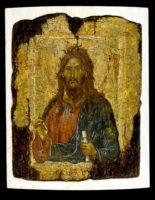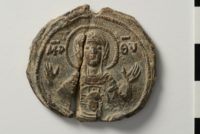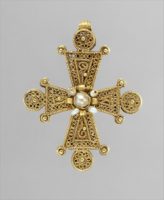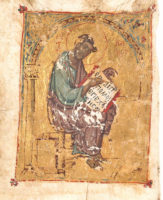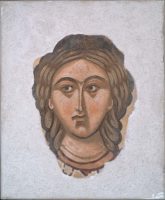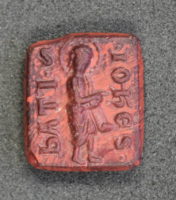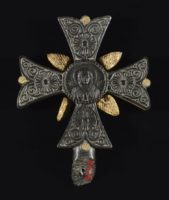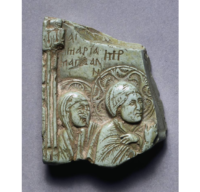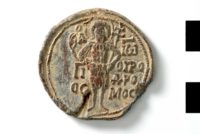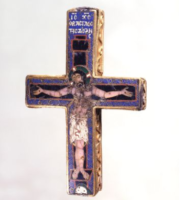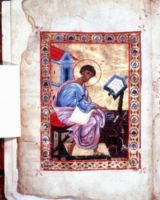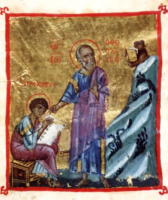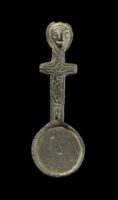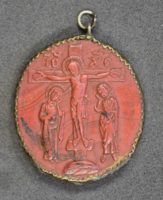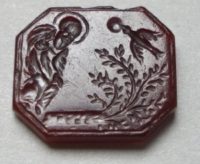Four Icons from a Pair of Doors (Panels), possibly part of a Polyptych: John the Theologian and Prochoros, the Baptism (Epiphany), Harrowing of Hell (Anastasis), and Saint Nicholas. Period: Late Byzantine, early 15th century, Made in Crete, Materials: Tempera and gold on wood. On view at The Met Fifth Avenue in Gallery 303. The Metropolitan Museum of Art (New York) is one of the world’s largest and finest art museums. Its collection includes more than two million works of art spanning five thousand years of world culture, from prehistory to the present and from every part of the globe. Public Hours: 10:30 a.m.–5:30 p.m. Open seven days a week.
Icon with St John the Baptist, Icon painted in egg tempera with gold leaf on a wood panel surfaced with gesso and linen; the panel has a raised border. Period: Late Byzantine, 1300 (circa), Made in: Constantinople (Modern Istanbul, Turkey). Dimensions: Height: 251 millimetresWidth: 202 millimetres. British Museum is closed 24, 25 and 26 December and 1 January, but is open every other day of the year. Fast facts about the British Museum: Founded: 1753, Collection size: 8 million objects, Oldest object in the collection: Stone chopping tool (nearly 2 million years old).
Constantine Xeros, Sebastos. Period: Late Byzantine, 12th.c. second half. Translation: May you, all-holy Virgin, be the keeper and seal of the correspondence of the sebastos Constantine Xeros. The museum is open to the public Tuesday through Sunday, 11:30 a.m.–5:30 p.m., except for federal holidays.
Cross with Pearls, Period: Late Byzantine, circa: 1200–1400. Materials: Gold and pearls. On view at The Met Fifth Avenue in Gallery 303. The Metropolitan Museum of Art (New York) is one of the world’s largest and finest art museums. Its collection includes more than two million works of art spanning five thousand years of world culture, from prehistory to the present and from every part of the globe. Public Hours: 10:30 a.m.–5:30 p.m. Open seven days a week.
Saint Luke, Byzantine Manuscript, cutting from a Greek Bible. Period: Late Byzantine circa: 1200–25. The MFA is open 7 days a week. Monday and Tuesday 10 am–5 pm, Wednesday–Friday 10 am–10 pm, Saturday and Sunday 10 am–5 pm.
Head of a Female Saint, Fresco transferred to panel, Period: Late Byzantine circa: 12th-14th centuries. The MFA is open 7 days a week. Monday and Tuesday 10 am–5 pm, Wednesday–Friday 10 am–10 pm, Saturday and Sunday 10 am–5 pm.
Cameo; red glass; quadrangular; Period: 13thC, Late Byzantine. Figure of St John the Baptist in relief with inscription. Made in: Venice. British Museum is closed 24, 25 and 26 December and 1 January, but is open every other day of the year.
Benediction Cross, Period: Late Byzantine, circa: 1200s-1400s. Materials: black schist, gold, silver. The Cleveland Art Museum Hours: Tuesdays, Thursdays, Saturdays, Sundays 10:00 a.m.–5:00 p.m. Wednesdays, Fridays 10:00 a.m.–9:00 p.m. Closed Mondays.
Fragment of an Icon of the Crucifixion with Mary Magdalen and the Virgin Mary. Material: Steatite. Period: 14th century, Late Byzantine. The Cleveland Art Museum Hours: Tuesdays, Thursdays, Saturdays, Sundays 10:00 a.m.–5:00 p.m. Wednesdays, Fridays 10:00 a.m.–9:00 p.m. Closed Mondays.
Seal, John Tarchaneiotes, Period: Late Byzantine, 13 th. century. (second half). St. John the Baptist standing, holding a staff cross over his left shoulder. The museum is open to the public Tuesday through Sunday, 11:30 a.m.–5:30 p.m., except for federal holidays.
Reliquary Cross with the Crucifixion, Period: Late Byzantine, circa: Late 12th-early 13th century. Materials: enamel on gold. The museum is open to the public Tuesday through Sunday, 11:30 a.m.–5:30 p.m., except for federal holidays.
Gospels of Luke and John, Period:Middle Byzantine, circa: Late 12th-early 13th century A.D. The museum is open to the public Tuesday through Sunday, 11:30 a.m.–5:30 p.m., except for federal holidays.
Manuscript Leaf, St. John and Prochoros, Period: Late Byzantine, 13th century. The museum is open to the public Tuesday through Sunday, 11:30 a.m.–5:30 p.m., except for federal holidays.
Cameo; opaque red; Period: Late Byzantine circa: 13 thc. Materials: glass. Made in: Venice. The Crucifixion with St John and St Mary and inscription, in relief. British Museum is closed 24, 25 and 26 December and 1 January, but is open every other day of the year. Fast facts about the British Museum: Founded: 1753, Collection size: 8 million objects, Oldest object in the collection: Stone chopping tool (nearly 2 million years old).
Relief icon; Period: Late Byzantine, circa: 14-15th c. carved white steatite in the shape of half an oval; St George and the dragon with name inscribed. Length: 2 centimetres Width: 1.6 centimetres. British Museum is closed 24, 25 and 26 December and 1 January, but is open every other day of the year. Fast facts about the British Museum: Founded: 1753, Collection size: 8 million objects, Oldest object in the collection: Stone chopping tool (nearly 2 million years old).
Copper alloy counterpoise coin balance; in the form of a rectangular beam with transverse bar, Late Byzantine (13-14 thc.)
Relief plaque icon, depicting the Crucifixion with full-length figures of the Virgin on the left and St John on the right, Late Byzantine (13 thc). Materials: Steatite – Gold.
Gold Signet Ring, Period: Late Byzantine circa: 14thc. Made in: Constantinople. Diameter: 28 millimetres Weight: 375 grains. British Museum is closed 24, 25 and 26 December and 1 January, but is open every other day of the year. Fast facts about the British Museum: Founded: 1753, Collection size: 8 million objects, Oldest object in the collection: Stone chopping tool (nearly 2 million years old).
Glass Cameo, Period: Late Byzantine; circa: 13th century A.D. Brick-red, opaque; on the front, the Crucifixion with, the Virgin at left, St John at right. Set in a metal frame. Diameter: 51 millimetres. British Museum is closed 24, 25 and 26 December and 1 January, but is open every other day of the year. Fast facts about the British Museum: Founded: 1753, Collection size: 8 million objects, Oldest object in the collection: Stone chopping tool (nearly 2 million years old).
Octagonal intaglio, Period: Late Byzantine; circa: 14thc. Made in: Constantinople. Dimensions: Height: 1.7 centimetre. Material: sard. British Museum is closed 24, 25 and 26 December and 1 January, but is open every other day of the year. Fast facts about the British Museum: Founded: 1753, Collection size: 8 million objects, Oldest object in the collection: Stone chopping tool (nearly 2 million years old).



